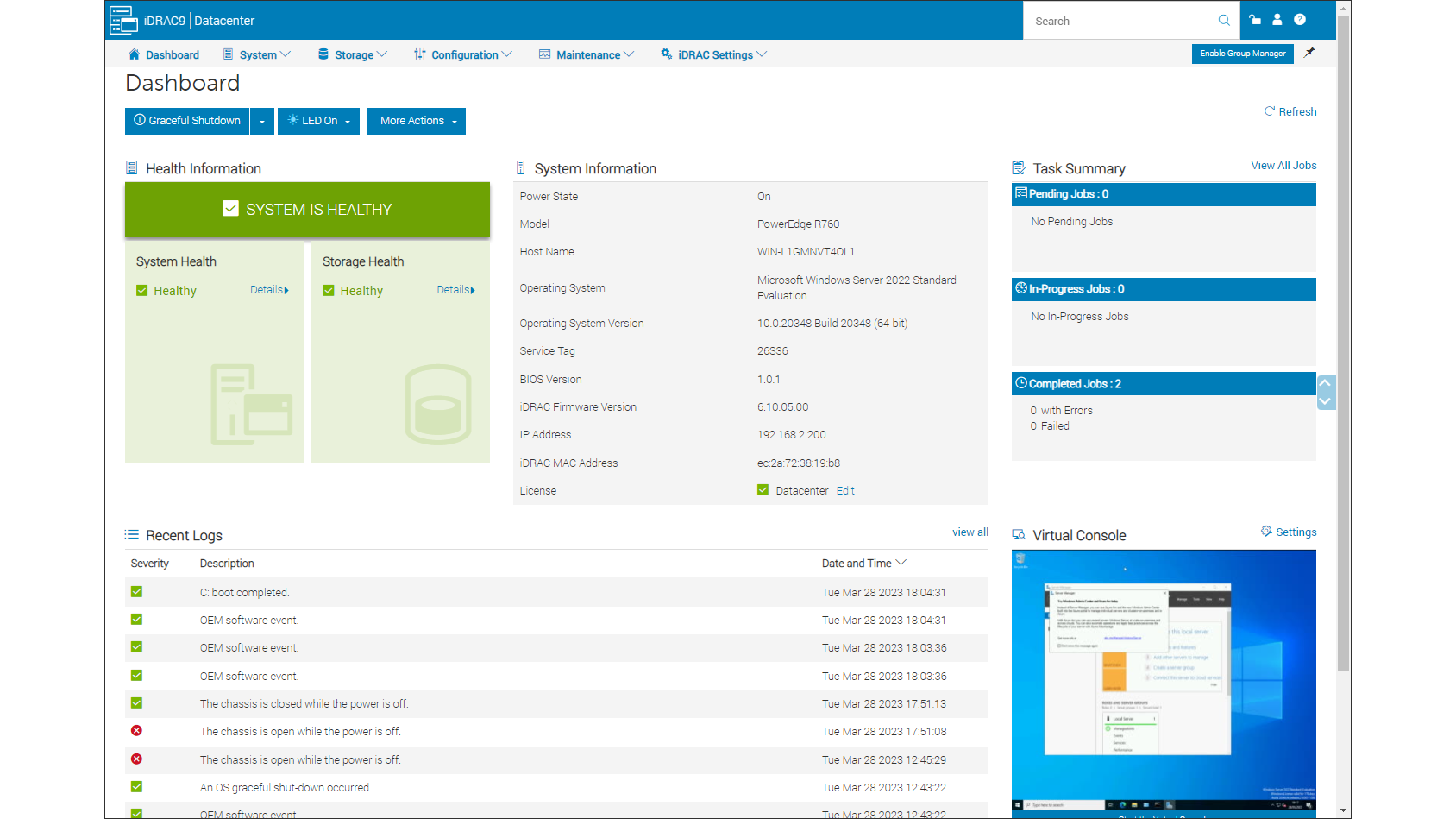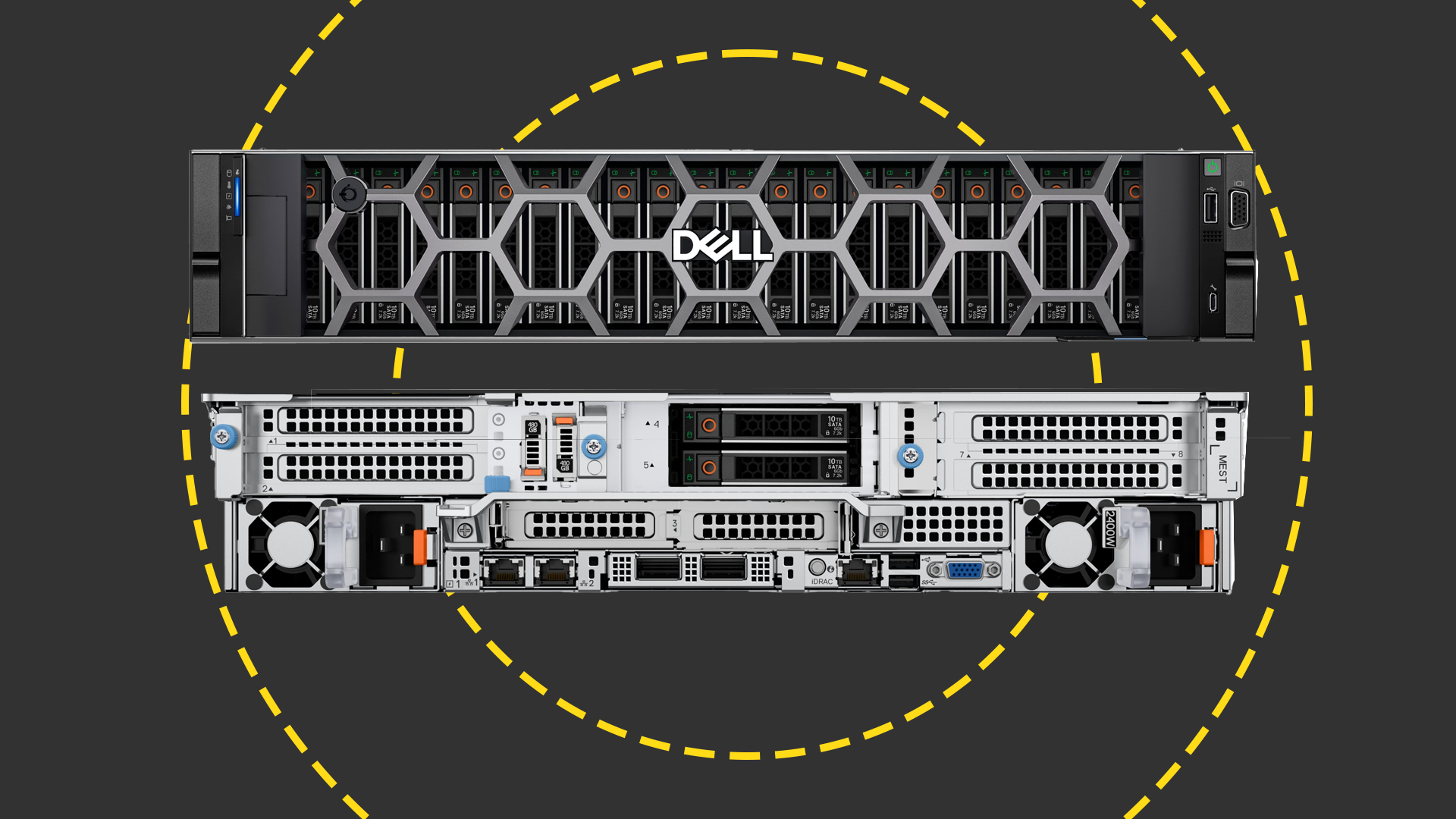Dell PowerEdge R760 review: A fourth-gen Xeon Scalable power station
A hugely powerful and versatile Gen4 Xeon Scalable rack server well-suited to demanding enterprise workloads


-
+
Smart Flow chassis
-
+
Gen4 Xeon Scalable CPUs
-
+
Versatile storage configurations
-
-
256GB DDR5 modules are expensive

It's been a very long wait but Intel's 'Sapphire Rapids' CPUs are finally here and Dell's PowerEdge R760 takes the honors by being the first production server through our lab doors to sport these fourth-generation Xeon Scalable chips. Targeting a wide range of enterprise and data center workloads including heavy-duty apps such as AI and ML, the R760 supports all the new Xeon Scalable CPUs up to the mighty 56-core Platinum 8480+, can present 8TB of fast 4,800MT/s DDR5 memory and brings PCIe Gen5 into play.
There's a lot more to talk about as the R760 introduces a new chassis design allowing it to offer an extensive range of storage options including SAS4 support along with E3.S and NVMe SSD configurations. Data centres will approve of Dell's new Smart Flow chassis options as these increase thermal capacity in air-cooled servers so they can support high-end 350W TDP CPUs, large memory capacities and up to 16 NVMe SSDs without the need for liquid cooling.
Dell PowerEdge R760 review: Server design
The front of our review system shows Dell's Smart Flow in action as it came with the central 8-bay drive cage replaced with a large air grill. Cracking the lid reveals a bank of six hot-plug fans behind the drive backplane and the same T-shaped motherboard as introduced in the R750.
This arrangement allows the PSUs to be placed on each side of the chassis to improve airflow throughout and ensure there are no hot spots. In practice it works well as the two 300W TDP 36-core Xeon Scalable Platinum 8452Y CPUs in our server stayed as cool as cucumbers during testing.
The general internal design is very tidy with the CPUs covered by large passive heatsinks and flanked on each side by eight DIMM slots with our system supplied with a healthy 1TB of DDR5 memory made up of sixteen 64GB modules. Only those with deep pockets and seriously heavy workloads will want to upgrade to the maximum 8TB as 256GB octo-rank RDIMMs currently cost over 16 grand apiece.

Further back you'll find three riser cards allowing the R760 to present a maximum of eight PCIe slots and you can specify up to four Gen5 slots. GPU options are equally impressive as there's room at the back for two 350W double-width or six 75W single-width cards although you'll need to be mindful of Dell's thermal restrictions when fitting these.
Dell PowerEdge R760 review: Storage choices
We thought the storage choices offered by Dell's 15G PowerEdge R750 were pretty good but the R760 takes these to the next level. Standard chassis support 12 LFF or 24 SFF bays at the front and dispensing with the central riser card makes room for a rear cage that adds a further 2 LFF or four SFF bays.
Sign up today and you will receive a free copy of our Future Focus 2025 report - the leading guidance on AI, cybersecurity and other IT challenges as per 700+ senior executives
They'll require a special backplane, but up to 16 E3.S form-factor NVMe SSDs can be front mounted with Gen5 support on the horizon. Dell also advised us it will soon be making an E3.S rear cage available that will accept four more.
All the PERC (PowerEdge RAID card) 11 options from the previous 15G generation are present and correct but our system came with two of the new PERC 12 Front H965i adapters nestling behind the 8-bay SFF drive cages. These tri-mode cards support SATA, SAS4 and Gen4 NVMe devices plus all the usual RAID suspects and come with 8GB of onboard DDR4 cache protected by energy packs.
There's more as the new BOSS (boot-optimized storage solution) card is not the same as the old BOSS. The N1 version dispenses with M.2 SATA SSDs in favour of higher-performing M.2 NVMe SSDs and we used the two 480GB sticks in our server to create a mirrored array and deploy Windows Server 2022 to it.
Dell PowerEdge R760 review: Management and monitoring
The embedded iDRAC9 remote management controller doesn't see any significant updates but none are really needed as it's still the one to beat. It presents a slick web console offering a wealth of information on system and component status, power usage and cooling efficiency along with a hardware inventory plus direct access to BIOS and storage configurations.
Support staff will approve of the optional Quick Sync 2 module as it provides walk-up diagnostics for mobile devices. Using the OpenManage Mobile (OMM) iOS app on an iPad, we connected directly to the server over Bluetooth and viewed all server information, alerts and the health status of hardware components.
We run the OpenManage Enterprise (OME) software in the lab as a Hyper-V VM and after it discovered the server's iDRAC9, we could manage and monitor it, control power, and run remote control sessions. Plenty of plug-ins are available for OME with the Power Manager particularly impressive.
Activated with an OME Enterprise Advanced licence, the latest version of Power Manager presents twelve graphs showing everything from CPU, storage, memory, fan, and FPGA power consumption to component utilization and airflow in CFM (cubic feet per minute). With support for up to 8,000 systems, it can enforce per-rack power cap and thermal event-based policies to automatically throttle servers back as required while the EPR (emergency power reduction) feature can push out a mass policy to selected groups forcing all members to drop to a low power mode or be gracefully shut down.
The Dell PowerEdge R760 delivers a powerful hardware package capable of running the most demanding data center apps and as one of the first Gen4 Xeon Scalable servers to market, it sets a high standard for the competition. A clever internal design allows its 2U chassis to offer a remarkable range of storage options, the Smart Flow chassis will appeal to data centers that want to avoid the expense of liquid cooling and remote management and monitoring services are simply the best.
Dell PowerEdge R760 specifications
| Chassis | 2U rack |
| CPU | 2 x 36-core 2GHz Intel Xeon Scalable Platinum 8452Y |
| Memory | 1TB 4,800MT/s ECC DDR5 (max 8TB) |
| Storage bays | 2 x 8-bay hot-swap SFF (max. 28 with rear bay) |
| RAID | 2 x Dell PERC H965i front SAS/SATA/NVMe 8GB cache with BBU |
| Storage included | 8 x 1.6TB mixed-use U.2 NVMe SSDs |
| Other Storage | Dell BOSS-N1 with 2 x 480GB M.2 NVMe SSDs |
| Network | 2 x Gigabit LOM, Broadcom dual 10/25GbE OCP 3 |
| Expansion | 8 x PCIe 4/5 slots, 1 x OCP 3 edge slot |
| Power | 2 x 1,400W Platinum hot-plug PSUs |
| Management | Dell iDRAC9 Enterprise 16G, Quick Sync 2 module |
| Warranty | 3Yr Basic On-Site NBD |
Dave is an IT consultant and freelance journalist specialising in hands-on reviews of computer networking products covering all market sectors from small businesses to enterprises. Founder of Binary Testing Ltd – the UK’s premier independent network testing laboratory - Dave has over 45 years of experience in the IT industry.
Dave has produced many thousands of in-depth business networking product reviews from his lab which have been reproduced globally. Writing for ITPro and its sister title, PC Pro, he covers all areas of business IT infrastructure, including servers, storage, network security, data protection, cloud, infrastructure and services.
-
 Trump's AI executive order could leave US in a 'regulatory vacuum'
Trump's AI executive order could leave US in a 'regulatory vacuum'News Citing a "patchwork of 50 different regulatory regimes" and "ideological bias", President Trump wants rules to be set at a federal level
By Emma Woollacott Published
-
 Microsoft Excel is still alive and kicking at 40 – and it's surging in popularity as 82% of finance professionals report ‘emotional attachment’ to the spreadsheet software
Microsoft Excel is still alive and kicking at 40 – and it's surging in popularity as 82% of finance professionals report ‘emotional attachment’ to the spreadsheet softwareNews A recent survey found Gen Z and Millennial finance professionals have a strong “emotional attachment” to Microsoft Excel
By Emma Woollacott Published
-
 LastPass hit with ICO fine after 2022 data breach exposed 1.6 million users – here’s how the incident unfolded
LastPass hit with ICO fine after 2022 data breach exposed 1.6 million users – here’s how the incident unfoldedNews The impact of the LastPass breach was felt by customers as late as December 2024
By Emma Woollacott Published
